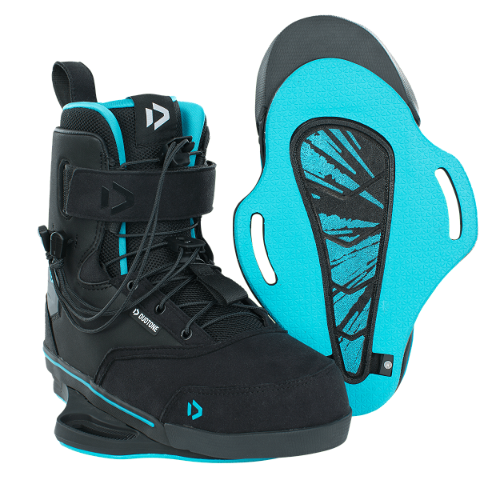DUOTONE BINDINGS & BOOTS
The skeleton of a foot consists of 28 bones. The foot bones can be divided into following groups: tarsal bones, metatarsal bones and phalanxes. 20 muscles and over 114 tendons and ligaments ensure the required flexibility and stability of the bones to each other. A fine nerve and blood vessel network supplies the surface and deeper muscles above and below the foot. Long story short, that’s exactly why you need the right gear.
THE STANCE - WHICH POSITION SHOULD I FIT MY BOOTS OR STRAPS IN?
WIDE STANCE
+ more stability in landings
+ can hold more power
- increased inner side knee injury risk with overwide stance
NARROW STANCE
+ greater maneuverability
+ less resistance in rotations
Taller people need a wider stance than shorter people. To find your stance width, jump forward and land in a comfortable squad position.

CENTRED PADS
+ more stability in landings (weight lands through centre of board)
- harder to edge heelside with small feet
CLOSER TO HEELSIDE
+ easier to edge on heels for upwind and jumping
- less stability in landings (weight lands off centre)
- harder to edge toeside
If you suffer pain in shins, move position towards heels for easier edging.

DUCK FOOTED (WIDE ANGLE)
+ more maneuverbility in various riding styles (e.g. carving and toeside)
- increased inner side knee injury risk with over ducked stance
PARALLEL STANCE
+ greater stability in landings
+ less resistance in rotations
If suffering pain at the inside of knee, move angle closer to parallel. look for your natural foot angle when you squat.

:grayscale(false):quality(10):blur(20))
:grayscale(false):quality(10):blur(20))
:grayscale(false):quality(10):blur(20))



:grayscale(false):quality(10):blur(20))
:grayscale(false):quality(10):blur(20))
:grayscale(false):quality(10):blur(20))